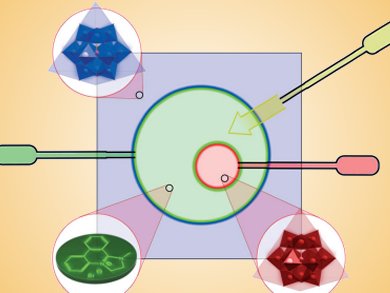Leroy Cronin and co-workers, University of Glasgow, UK, have developed a method to produce flexible membranes that can form cell-like compartments with tunable functionality. The inorganic chemical cells (iCHELLs) were formed at the liquid–liquid interface between aqueous solutions of polyoxometalate clusters (POMs, blue in picture) and organic/coordination-complex cations (green). Formation was achieved through an extrusion-exchange mechanism, in which the small cations, such as H+ or Na+ ions, associated with the large POM anions are exchanged for the larger organic cations.
The POM building blocks impart enhanced functionality to the membranes including redox, catalytic, photochemical, and magnetic properties. The ion-exchange process allows the design of chiral or nested cells simply through choice of the reagents. Individual iCHELLs could be used as catalysts that can selectively import reagents. iCHELLs nested within one another potentially allow stepwise reactions to occur in sequence within the cell.
Image: © Wiley-VCH
- Modular Redox-Active Inorganic Chemical Cells: iCHELLs
G. J. T. Cooper, P. J. Kitson, R. Winter, M. Zagnoni, D.-L. Long, L. Cronin,
Angew. Chem. Int. Ed. 2011.
DOI: 10.1002/anie.201105068 - Videos showing the formation of iCHELLs




